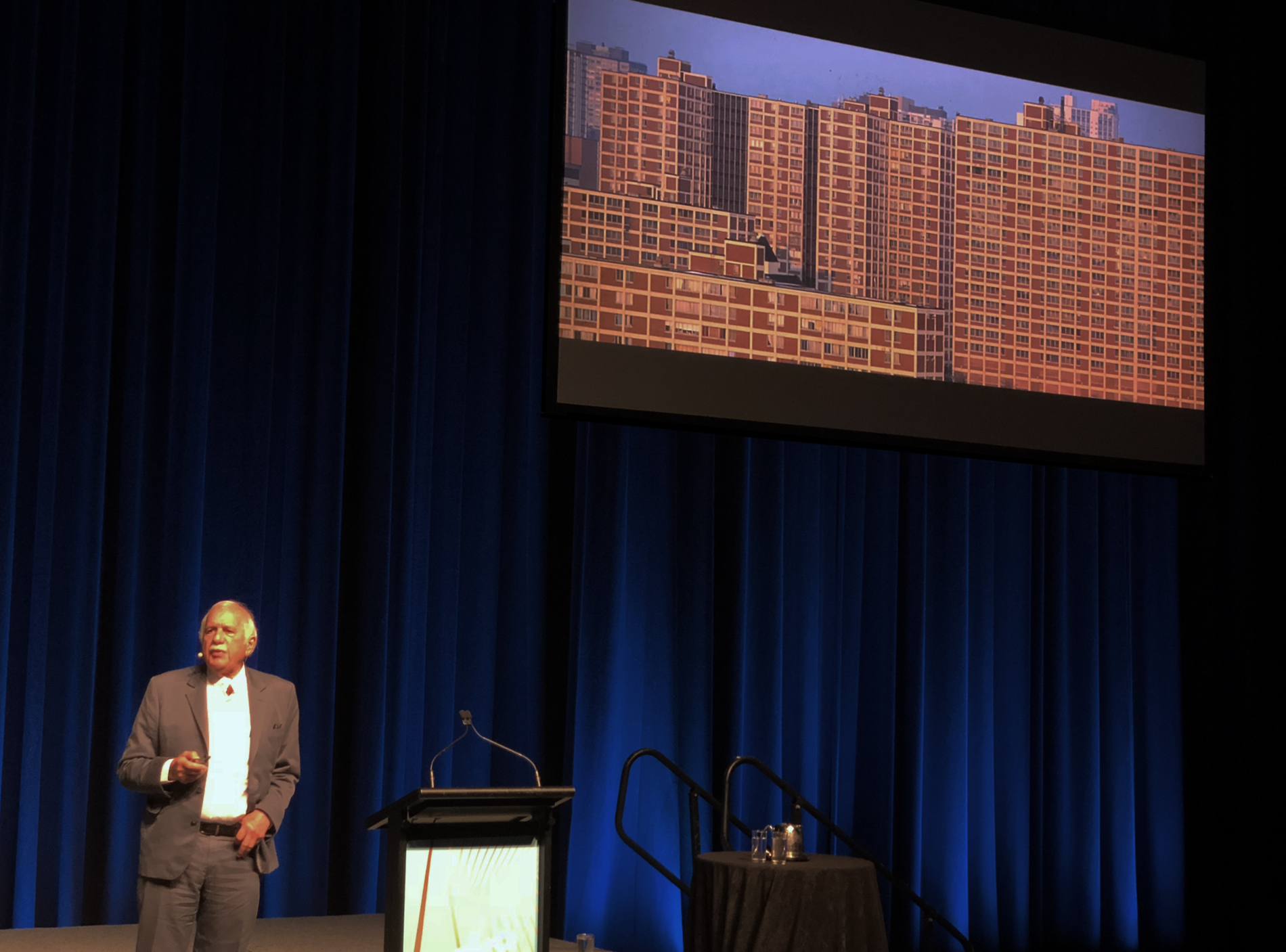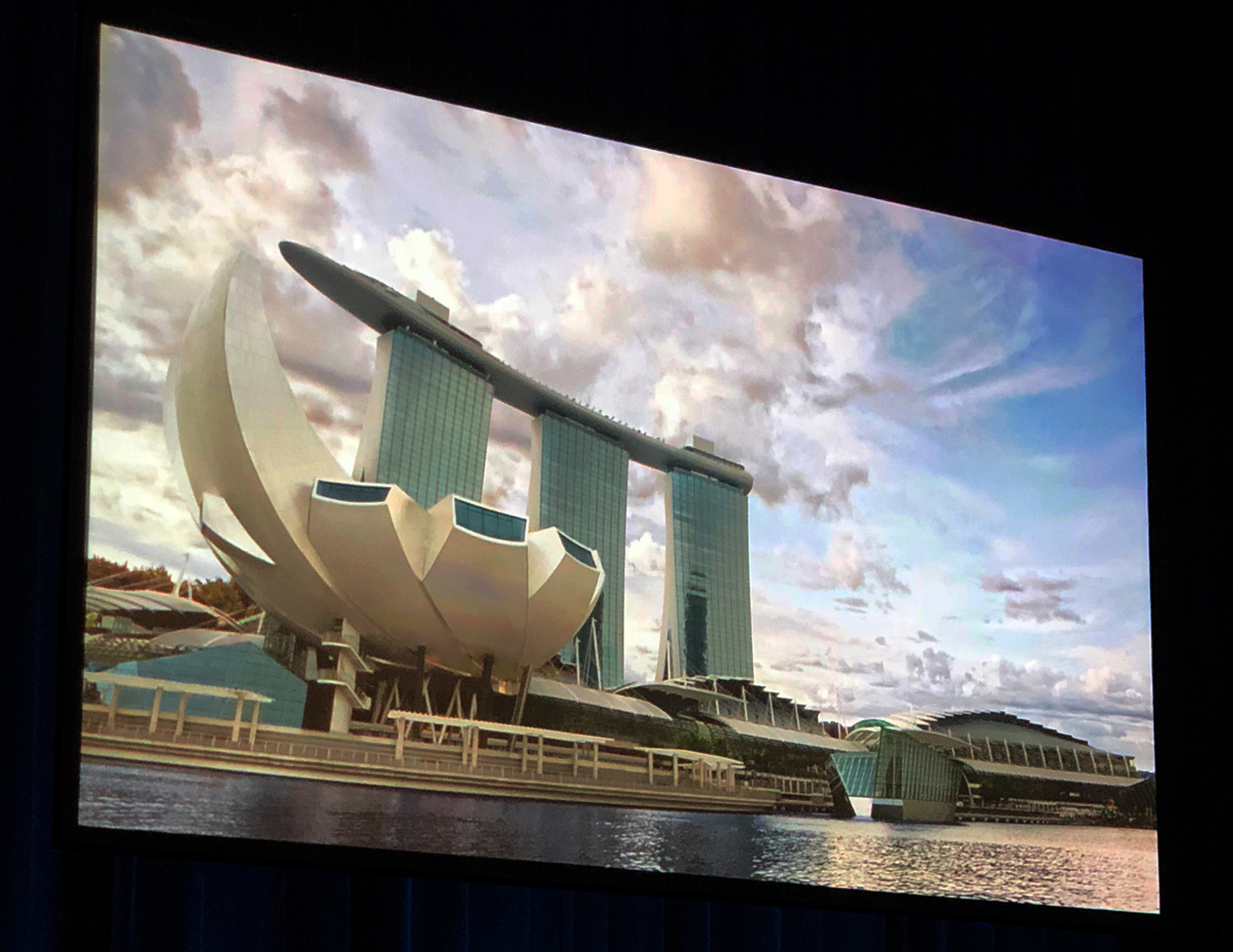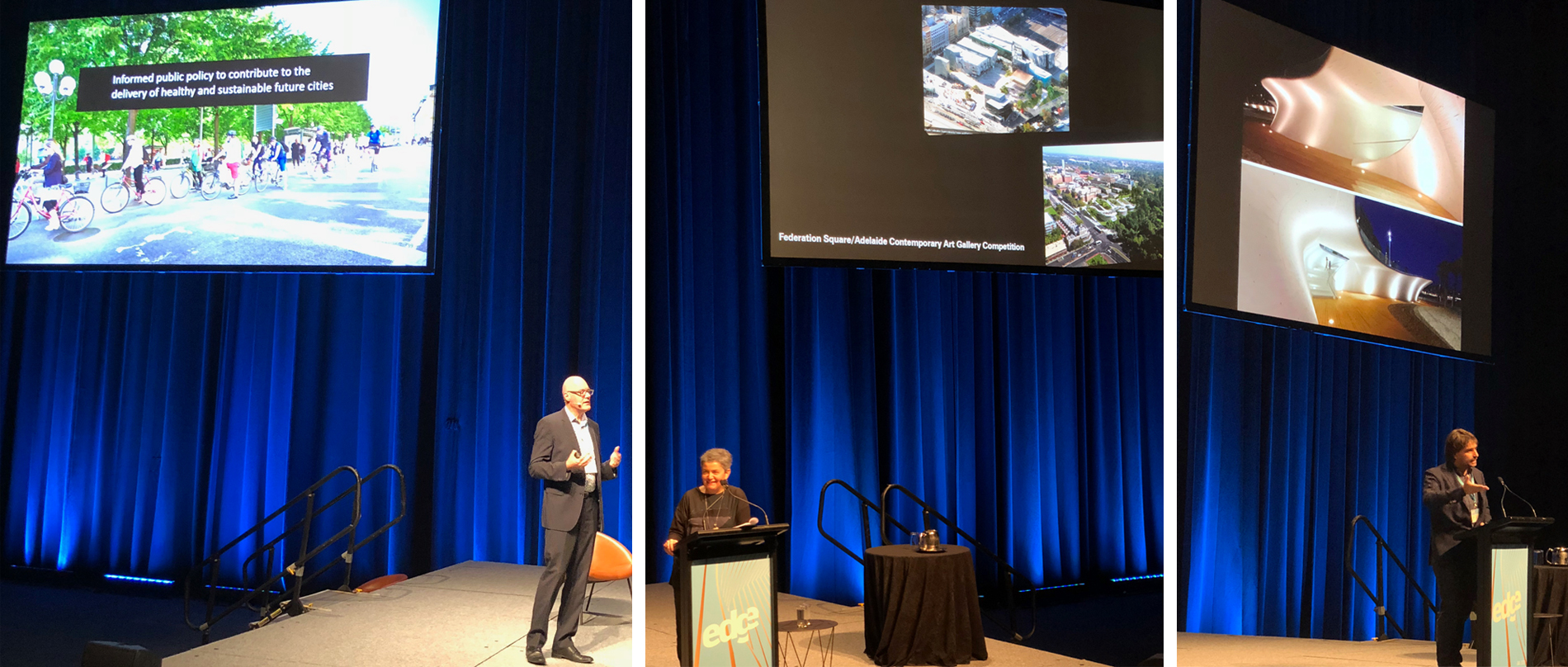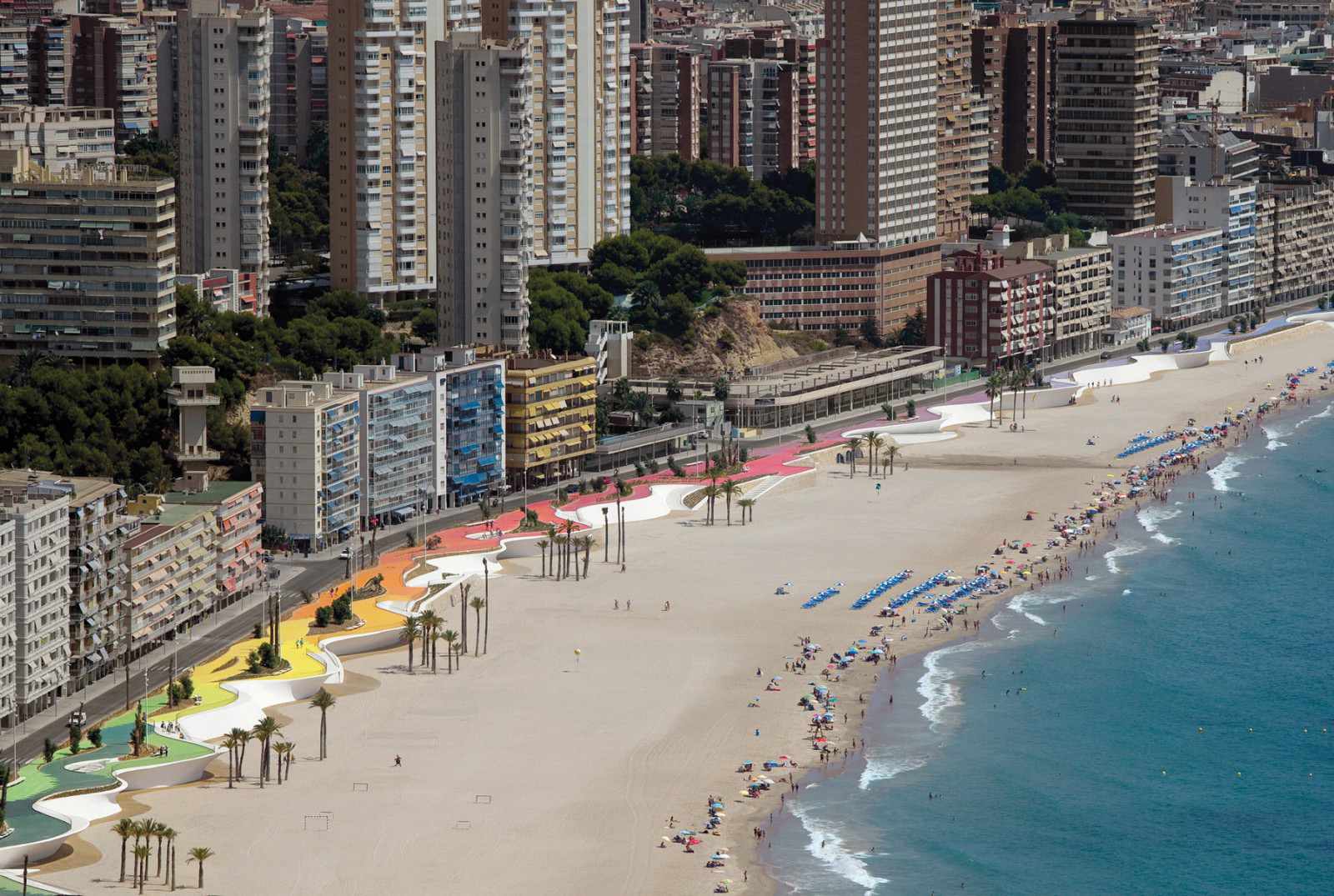What are the forces at play in the 21st Century that are changing the ways architects design our built environment? What is happening at the extremes of mass urbanisation, with international mega projects, big data and digital technologies? What is happening at the edges of architecture, both internationally and in Australia?
These questions form part of the ambitious theme ‘EDGE’ for the Australian Institute of Architects 2018 National Conference. The location for this two day extravaganza is arguably Australia’s most extreme city, the Gold Coast in Queensland. Set between the iconic beach and the subtropical rainforest is a city dramatically imposing its own edges on the landscape. The creative directors for the conference are Wei Jien, Barry Lee and Brett Saville.
The last time the Gold Coast was host to the National Conference it was a radically different place. In his opening remarks to the conference, immediate past president of the Institute Richard Kirk noted that during the last AIA conference at the Gold Coast (1959), the tallest building in the city was only five storeys high. It has been a very long time between drinks.
Taking you through the highlights of Edge 2018 are Michael Smith and Chelsea Doorne from Atelier Red+Black.

Moshe Safdie
(Review Chelsea Doorne)
It is it fitting that the last time that the conference was on the Gold Coast was the genesis of what is arguably the most well-known of Safdie’s works, Habitat 67. Having studied the housing typology of North America, Safdie noted that those who occupied multi-residential housing were there against their will, constrained by their income classification, while those identifying as middle to upper class preferred to reside in the suburbs. These early examples of multi-residential typology were oppressive and provided a poor quality of life, resulting in no one inhabiting these buildings by choice.
Concerned by this, he used his thesis to investigate a rethinking of the apartment typology with a desire to insert the quality of life experienced by those living in houses into a multi-level apartment building, concentrating on the merging of density and quality. Habitat 67 focused on what we know is integral to a high living standard; access to natural light, integration with the streetscape and personal private space. However, while Habitat 67 was a social success, it was not a model which became replicated around the world. Rather, the mistakes that have always been made in high rise living continued in the 40 plus years of urban development with the ‘mistakes of the West occurring in the East’.
A study of Midtown Manhattan led to a mapping of the square footage of commercial, residential and retail with a restacking of these elements, allowing for a typology that is porous in nature, removing the typical barrier like construct of the high-rise which sits atop the bulky podium – which Safdie aptly termed the “kiss of death”. This was particularly fitting given the Gold Coast location where any views to the coastline are hidden behind a barrier of outdated high-rises.
“Every mistake of urbanism in the West, recurred in the East and in China”
Moshe Safdie
Concluding his brilliant presentation with the self-imposed question of what inspires him, the answer of nature brilliantly tied together his extensive portfolio. Safdie’s passion to create high quality density was evident to the entire audience in multiple projects. From Sky Habitat which replicates the connection provided by streets onto the 25th floor to the Marina Bay Sands which dedicates 50% of its roof area to parks, gardens, and pools, Safdie’s passion to create high quality density was evident to the entire audience.
.

Marina Bay Sands by Safdie Architects
Mark Stevenson
(Review Michael Smith)
Professor Mark Stevenson is an epidemiologist and Professor of Urban Transport and Public Health at the University of Melbourne. To begin his presentation, Stevenson took the audience back to the 1850’s when the theory of Miasma was influencing city shaping policy decisions. The concept of Miasma was that the polluted smells of dense cities were transmitting disease. This was later discredited by the science of John Snow who found evidence that it was in fact contamination within water supplies that were causing cholera. With this story as background, Stevenson explained the cutting edge of understanding city health.
By combining Google Street View data and health survey information through machine learning algorithms, it is now possible for Stevenson’s multi-disciplinary team to reverse engineer the process to determine whether images of streetscapes are more likely to be correlated with healthy or unhealthy neighbourhoods. Whilst this particular analytic approach is in its infancy, it provides an interesting insight into how our future cities will be analysed and redesigned in order to improve the overall health of the population.
Stevenson also described an analysis of the direct impact of compact cities on transportation related health outcomes. His team investigated the impacts of denser, more diverse cities with closer public transport, where 10% of kilometres travelled in motor vehicles were transferred to riding/walking. They saw that in Melbourne, this would result in a significant benefit for chronic health conditions, but cause an increase in road trauma impacts. They also investigated much infrastructure would be required separating cars and bicycles to mitigate this impact.
James Grose
(Review Chelsea Doorne)
James Grose of BVN focused his presentation on the visceral, the agrarian and the utilitarian. Inspired by his childhood in Bundaberg, the rethinking of the humble Australian shed was a stand out feature of his early presented works while still operating in the small practice of Grose Bradley.
The concept of visceral design, interacting with its inhabitants through sense and feel, was a clear theme of their work. The projects he presented focused on a repetition of structure, allowing inhabitants to easily read how the building works. They also designs spaces that have their life and character provided by the people within it rather than “phony architecture.”
The most consistent theme in all of their work was the importance of symbolism and connection to a place. Some excellent examples were the inspiration drawn from the structure of a gumnut pod in the CSIRO Synergy Building, and the focus on the humble Aussie verandah in the Greenland Centre.
Eli Giannini
(Review Michael Smith)
Presenting a journey through the practice of MGS Architects, Giannini brought us back to a more familiar scale of work with various residential buildings in a variety of contexts. Central to the DNA of the MGS Architecture practice is a broad collection of expertise across directors that are brought in to projects at the earliest of stages. Rather than driving a design via a singular architect or ‘starchitect’, MGS utilize an active collaborator approach that focuses on delivering early design knowledge. They also advocate “designing from a position of strong culture” to ensure the design response respects context and site.
Another theme from Giannini’s presentation was the uptake and mastering of digital tools in practice. Her career has spanned the transition from manual tools through to the early CAD tools and now into more sophisticated building modelling. Reflecting upon this transition, Giannini noted the fortunate accidents that these new tools could sometimes produce, which can push designs to unexpected places.

Professor Mark Stevenson, Eli Giannini and Borja Ferrater
Roberto Bannura
(Review Chelsea Doorne)
While many parallels can be drawn between the presentations of Roberto Bannura of Steven Holl Architects and Moshe Safdie, with both having a desire to provide better quality of living in high density living, the outcomes did appear drastically different. Though the images presented in the presentation were undoubtedly beautiful, the claims of these designs to be tailormade to the location didn’t quite match the heavy use of renders in lieu of finished shots of the spaces being used by the public. Both Bannura and Safdie emphasised the need for green space in these designs, however while Safdie terraced these gardens to allow for private ownership and personalisation, those featured in the projects presented by Bannura dominated the public plazas, appearing more harshly landscaped and requiring larger areas of hard surface. Ultimately it was hard to not compare the presentations, with the integrity of Safdie and his desire to truly improve high density, unfortunately making the outcomes as presented by Bannura appear to be somewhat shallow.
Borja Ferrater
(Review Michael Smith)
The final presentation for day one was Borja Ferrater from Office of Architecture Barcelona (OAB) in Spain. Taking the audience through a selection of key projects, Farrater revealed an international practice which has a clear desire to produce architecture which carries a deep respect for the local context. Ferrater repeatedly spoke of the various local craftspeople, building traditions and business that were engaged on their projects to ensure a locally responsive design outcome. This once again touched on an ongoing theme throughout the day of the role of international architects and the threat of generic globalised thinking that leads to cities being stripped of character and nuance.
“We don’t want our projects to be a franchise”
Borja Ferrater
Perhaps the greatest project from the selection presented by Ferrater was the Benidorm West Beach Promenade in Spain. This urban landscape design forms a literal edge between the built environment and the beach using exquisite formed concrete, a vibrant colour palate and some sublime detailing. The quality and rigor of the work presented made the work of OAB one of the clear standouts for the day.

The Benidorm West Beach Promenade Photo Credit Alejo Bague
Click here to read on to day 2 of Edge 2018
You can also follow updates on social media via the hashtag #edgegc2018
Architecture is for everyone.
You may also like
2 Comments
Leave a Reply
Leave a Reply Cancel reply
Contact Us
Feel free to contact us with questions or feedback:
Latest Post
- A crisis of trust February 10, 2020
- The Square and the Park. October 28, 2019
- Fixing The Building Industry – A Wishlist September 12, 2019
- 2019 NATIONAL CONFERENCE DAY 2 June 24, 2019
- 2019 National Conference Day 1 June 22, 2019



Great to read your rapid-fire response as always. Curious to know how you think the different presenters engaged with the conference theme, and which do so better / worse?
Thanks for your question Warwick,
I think many speakers this year had only a limited engagement with the set topic of edges. Perhaps the most notable exception to this being Sue Dugdale on day 2. There was also almost no discussion on the host city of the Gold Coast, which seemed to have inspired the theme. That said there was still some great comparisons to be made between the speakers, in how they addressed local context, as well as a couple of speakers that operate at (or near) the edge of architectural practice.